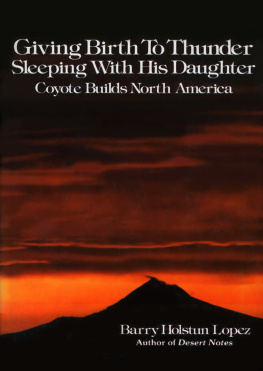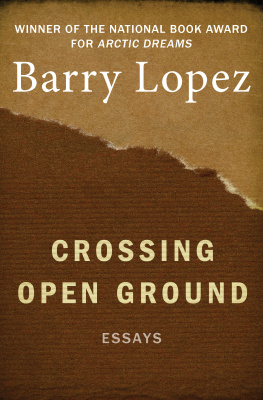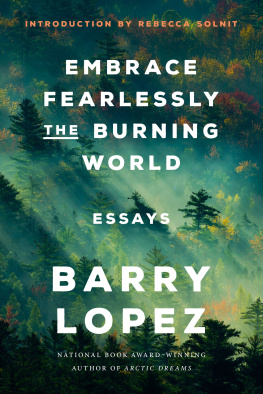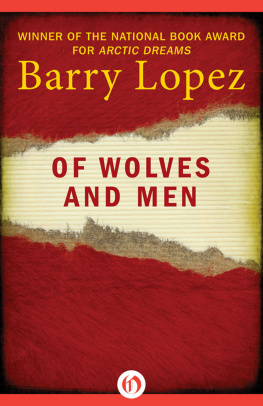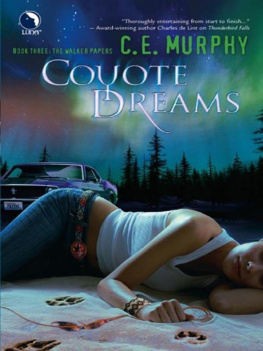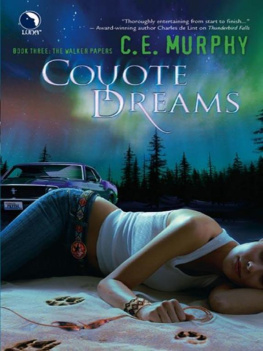Giving Birth to Thunder,
Sleeping with His Daughter
Also by the Author
Desert Notes: Reflections in the Eye of a Raven (1976)
River Notes: The Dance of Herons (1979)
Giving Birth to Thunder, Sleeping with His Daughter
Coyote Builds North America
Barry Holstun Lopez

To the Native Peoples of North America
that we may now share a little of each others laughter in addition to all our tears
Contents
Foreword
This is not a scholarly book; but then, Old Man Coyote is not a scholarly character. He has consistently evaded academic capture and definition and has tricked nearly every commentator into at least one outrageous and laughable generalization. He is blamed and praised by a wide variety of native tribes for originating death, mixing up the stars, fornicating with birds, bringing fire, losing his eyes, freeing the buffalo; and he is blamed by one anthropologist for nearly putting the American Folklore Society out of business in the 1930s (John Greenway, Folklore of the Great West [Palo Alto: 1969, pp. 89]).
On the Warm Springs Indian Reservation in central Oregon, some people tell a story about a wandering anthropologist who came across a coyote caught in a trap.
Please let me out of this trap; if you do, Ill give you lots of money, the coyote said.
Well, Im not sure. Will you tell me a story, too? asked the professor.
Sure I will; Ill tell you a real, true story, a real long one for your books.
So the anthropologist sprung the trap, collected a big handful of bills from the coyote, and then set up his tape machine. The coyote sat, rubbing his sore legs, and told a long story that lasted until the tape ran out. Then he ran off.
The anthropologist went home and told his wife about what happened, but she wouldnt believe him. When he reached in his pocket to show her the money, all he came out with was a handful of fur and dirt.
And when he went to play his tape for the other professors, all that was in the machine was a pile of coyote droppings.
A person from another tribe might hear this story, smile, and say, Oh yes, theres that old Coyote up to his tricks again. A Sioux might say, We tell the same stories about Iktomi, the Spider, and the Eskimo would add, Up our way, its about the Crow. Only the anthropologist would object, and point out that, after all, these tribes have different and distinct concepts of the Trickster figure and one must not allow the distinctions to be blurred; furthermore, the story as told is recent, an obvious byproduct of acculturation and the attendant breaking down of older traditions. In his zeal for scholarly propriety and with perfectly acceptable academic myopia, the anthropologist might easily and proudly overlook several important aspects of Old Man Coyote: that he is alive and well in the modern world, that he has survived acculturation (and triumphed over it), thatin spite of tribal differencesthere is a broadly recognizable cluster of characteristics we still know as his own, regardless of our tribal backgrounds. It is this personality profile, and not the scholars fossil, that. Barry Lopez presents in this collection. Say, if you will (and some have), that Coyote is the exponent of all possibilities through whose antics and actions we see ourselves and the moral ramifications of our thoughts; or say that Coyote is the philosophical embodiment of a native world view of relationships between mankind and nature; or say that Coyote is a freak of the primitive mindthe impulsive and self-destructive character that proves the savage did not have it all together. Or say simply that Coyote is a Gemini. All these things are true; all these things are false.
In spite of my heavy-handed joking about anthropologists, however, I should make it clear that to get beyond Coyotes fascinating faade we do in fact need to know his local, specific tribal manifestations. And to know these, we need to know the tribal language, the tribal lore about story-telling events, and the local taboos concerning when a story may be told, by whom, to whom, and under what circumstances. In many cases, the sources of this learning are unavailable to ussome have been destroyed utterly, and those remaining are reluctant to share what there is. But suppose we could learn Navajo, for example, along with all the folkloristic, socio-linguistic details we would need to have in mind in order to hear and respond to a Navajo Coyote tale under normal conditions, in its regular habitat. Among other things, we would have learned that Coyote stories must be told only after the first killing frost and before the first thunderstormthat is, in wintertime as defined by nature itself. Knowing that, how could we tolerate the existence of this very book, since it will make the stories available any time?
Or, suppose we learn the Coos language, so as to hear of Old Man Coyote in the old, traditional wayonly to find out that the stories must remain oral to be alive, that at least two others who know the story must always be present at the telling, and that each tale may be told by a given person only once in the season. Would we not in good conscience refuse to cooperate in the making of this book, or, at second best, would we not at least destroy every copy of it we could find so as to insure that our live oral traditions would not be killed off?
And what will the owner and reader of this book say if a member of some tribe approaches him and says, Look, in my tribe, all stories are owned by someone, or by some clan. In that book you have there are some stories which were stolen from us, taken and printed without proper permission or ritual. And you are an accessory after the fact?
Clearly, this is a potentially dangerous book, then, and Lopez has approached the job in the only way I can see as defensible. It does not pretend to be an Indian book. It does not provide the original language, the ritual detail, the full context; in short, it does not give away or betray the magic of the actual storytelling event. Instead, the stories are retold in a way that is both faithful to native concepts of Coyote and how his stories should go, and phrased for an audience which reads without listening, for whom literature is studied and reflected upon, for whom Coyote is an imaginary but interesting protagonist.
In these retellings, one important element of style is retained which relates more to the live contexts of the original stories than it does to the tastes of a reading public; a sense of locality, a feeling for placeboth geographic and sacredinfuses these dramatic narratives. Small details of geography, seemingly minor references to the color of a feather, the direction of the wind, the smell of grass or water, are all signals which awaken memories, trigger recognition, and allow for the re-experiencing of the texture and quality of a life locally known as it becomes a context for Old Man Coyotes universal adventures. This local perception of region, in all its connotative and sacred aspects, is almost as hard to capture as the Old Man himself. It is well for the reader to know that Lopez has made it his business to spend considerable periods of time experiencing the locales of these stories: he has sat for days in the Oregon desert, listening; he has camped and lingered among the trees and camass prairies of Nez Perce country looking for the spirit of the land; he has gone, and not as a tourist, into numberless reservation towns, Indian bars, and powwows; and he has come face to face with coyotes more than once. He has tried to look and see, not gawk. The result is a sense of what it means to hear of Coyote in different local contexts; this he has tried to incorporate into the style of the tales.

